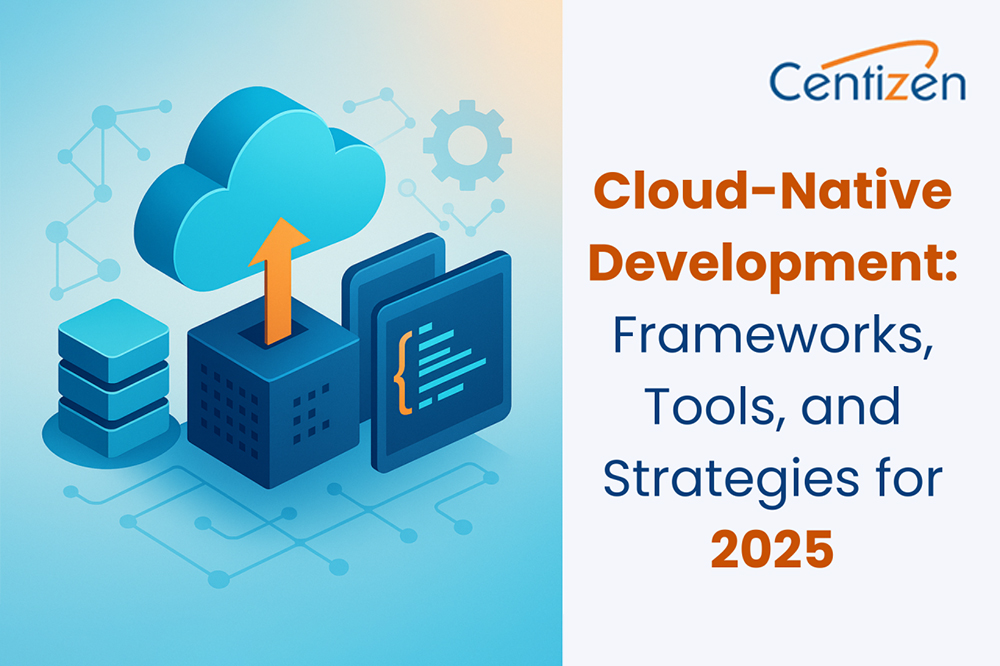Cloud-Native Development: Frameworks, Tools, and Strategies for 2025

Cloud-native development has become the gold standard for building scalable, resilient, and agile applications that thrive in today’s dynamic cloud environments. But simply running software on a cloud server doesn’t make it cloud-native.
In 2025, true cloud-native applications are built using purpose-driven design principles, modular architectures, and modern deployment techniques. This article dives into what makes an application cloud-native, the tools and frameworks that enable it, and the best practices to adopt for long-term success.
What is a cloud-native application?
A cloud-native application is architected specifically to leverage the cloud’s elasticity, scalability, and fault tolerance. Unlike traditional monolithic applications, cloud-native apps are:
- Modular: Broken into independent microservices
- Scalable: Dynamically adjust to user demand
- Resilient: Built to handle failure gracefully
- Automated: Integrated into CI/CD pipelines for fast, reliable deployments
According to the Cloud Native Computing Foundation (CNCF), cloud-native technologies include:
- Containers
- Microservices
- Immutable infrastructure
- Serverless computing
- Declarative APIs
- Service meshes
Core characteristics of cloud-native applications
- Microservices architecture: Independent services are built, deployed, and scaled separately, allowing for flexibility and faster innovation.
- Containerization: Provides consistent, lightweight environments across development and production, simplifying dependency management.
- Orchestration: Tools like Kubernetes manage service scaling, failover, and networking to ensure smooth operation.
- CI/CD pipelines: Automate the build, test, and deployment processes for faster and more reliable software delivery.
- DevOps culture: Promotes collaboration between development and operations teams to accelerate delivery cycles.
- Resilience and scalability: Applications are designed to recover from failures and scale automatically based on user demand.
- Distributed design: Services run across multiple nodes, ensuring fault tolerance and optimizing load distribution.
Programming languages for cloud-native development
- Go – Efficient, ideal for backend cloud services
- Java – Enterprise-grade with rich ecosystem
- Python – Versatile for APIs, automation, and ML
- JavaScript/Node.js – Event-driven, great for web and serverless apps
Containerization & orchestration tools
To run scalable, modular apps in the cloud, containerization and orchestration are must-haves.
Containers:
- Docker – Industry standard for container packaging
- Podman – Lightweight alternative compatible with Docker
Orchestration:
- Kubernetes – Orchestrates container deployments at scale
Top frameworks for cloud-native development
- Django (Python) Ideal for full-stack web development with rapid prototyping and a clean, pragmatic design.
- Micronaut (Java) Lightweight framework with fast startup times, perfect for building microservices.
- Quarkus (Java) Optimized for Kubernetes-native Java applications; offers low memory usage and fast boot time.
- .NET Aspire (.NET) Designed for building cloud-native .NET applications with strong Microsoft ecosystem support.
- Next.js (JavaScript) A React-based framework that supports server-side rendering; suitable for modern frontend development.
- Node.js (JavaScript) Great for lightweight APIs and real-time services with an event-driven, non-blocking architecture.
CI/CD tools for fast & safe deployments
A cloud-native strategy depends on continuous integration and delivery.
Popular CI/CD tools:
- GitHub Actions
- Jenkins
- GitLab CI
- Argo CD
- AWS CodePipeline
- Azure DevOps
These tools automate testing, packaging, and deployments, supporting techniques like canary releases and blue-green deployments for safer rollouts.
Observability and monitoring in cloud-native apps
You can’t manage what you can’t measure. Observability tools ensure visibility across your services.
Essential tools:
- Prometheus – Monitoring and alerting
- Grafana – Dashboards and visualization
- Jaeger – Distributed tracing
- OpenTelemetry – Unified logging, metrics, and traces
Best practices: The cloud well-architected framework
All major cloud providers have released Well-Architected Frameworks to guide cloud-native development:
Key pillars:
- Operational excellence – Monitor, learn, and refine processes
- Security – IAM, data encryption, and vulnerability response
- Reliability – Design for auto-recovery and redundancy
- Performance efficiency – Right-size resources, auto-scale
- Cost optimization – Reduce waste and maximize ROI
Providers:
- AWS Well-Architected
- Microsoft Azure Well-Architected Framework
- Google Cloud Architecture Framework
Conclusion: Building for the cloud, not just in it
Cloud-native development is not about where your app runs—it’s about how it’s built. By using microservices, containers, CI/CD pipelines, and modern observability tools, developers can deliver scalable, high-performing apps that evolve as user demands change.
In 2025 and beyond, cloud-native is no longer optional—it’s the foundation of modern software engineering.
Our services:
- Staffing: Contract, contract-to-hire, direct hire, remote global hiring, SOW projects, and managed services.
- Remote hiring: Hire full-time IT professionals from our India-based talent network.
- Custom software development: Web/Mobile Development, UI/UX Design, QA & Automation, API Integration, DevOps, and Product Development.
Our products:
- ZenBasket: A customizable ecommerce platform.
- Zenyo payroll: Automated payroll processing for India.
- Zenyo workforce: Streamlined HR and productivity tools.
Services
Send Us Email
contact@centizen.com
Centizen
A Leading Staffing, Custom Software and SaaS Product Development company founded in 2003. We offer a wide range of scalable, innovative IT Staffing and Software Development Solutions.
Call Us
India: +91 63807-80156
USA & Canada: +1 (971) 420-1700
Send Us Email
contact@centizen.com
Centizen
A Leading Staffing, Custom Software and SaaS Product Development company founded in 2003. We offer a wide range of scalable, innovative IT Staffing and Software Development Solutions.
Call Us
India: +91 63807-80156
USA & Canada: +1 (971) 420-1700
Send Us Email
contact@centizen.com






